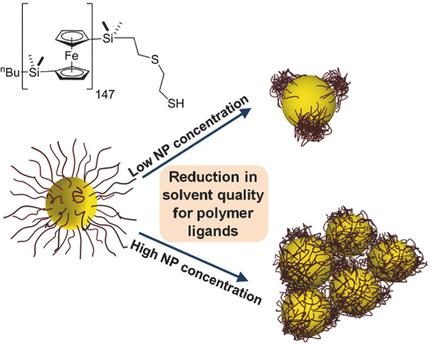当前位置:
X-MOL 学术
›
Macromol. Rapid Commun.
›
论文详情
Our official English website, www.x-mol.net, welcomes your feedback! (Note: you will need to create a separate account there.)
Self‐Assembly and Surface Patterning of Polyferrocenylsilane‐Functionalized Gold Nanoparticles
Macromolecular Rapid Communications ( IF 4.6 ) Pub Date : 2017-11-16 , DOI: 10.1002/marc.201700554 Rachelle M. Choueiri 1 , Anna Klinkova 1 , Samuel Pearce 2 , Ian Manners 2 , Eugenia Kumacheva 1
Macromolecular Rapid Communications ( IF 4.6 ) Pub Date : 2017-11-16 , DOI: 10.1002/marc.201700554 Rachelle M. Choueiri 1 , Anna Klinkova 1 , Samuel Pearce 2 , Ian Manners 2 , Eugenia Kumacheva 1
Affiliation

|
Chemical and topographic surface patterning of inorganic polymer‐functionalized nanoparticles (NPs) and their self‐assembly in nanostructures with controllable architectures enable the design of new NP‐based materials. Capping of NPs with inorganic polymer ligands, such as metallopolymers, can lead to new synergetic properties of individual NPs or their assemblies, and enhance NP processing in functional materials. Here, for gold NPs functionalized with polyferrocenylsilane, two distinct triggers are used to induce attraction between the polymer ligands and achieve NP self‐assembly or topographic surface patterning of individual polymer‐capped NPs. Control of polymer–solvent interactions is achieved by either changing the solvent composition or by the electrooxidation of polyferrocenylsilane ligands. These results expand the range of polymer ligands used for NP assembly and patterning, and can be used to explore new self‐assembly modalities. The utilization of electrochemical polymer oxidation stimuli at easily accessible potentials broadens the range of stimuli leading to NP self‐assembly and patterning.
中文翻译:

聚二茂铁基硅烷官能化金纳米粒子的自组装和表面构图
无机聚合物功能化的纳米颗粒(NP)的化学和地形表面图案及其在纳米结构中具有可控体系结构的自组装,使得能够设计新的基于NP的材料。用无机聚合物配体(例如金属聚合物)覆盖NP可以导致单个NP或其组件具有新的协同性能,并增强功能材料中的NP加工能力。在这里,对于用聚二茂铁基硅烷官能化的金纳米颗粒,使用两个不同的触发条件来诱导聚合物配体之间的吸引力,并实现单个聚合物封端的纳米颗粒的NP自组装或表面形貌。通过改变溶剂组成或通过聚二茂铁基硅烷配体的电氧化,可以控制聚合物与溶剂的相互作用。这些结果扩大了用于NP组装和构图的聚合物配体的范围,并可用于探索新的自组装形式。在容易获得的电势下利用电化学聚合物氧化刺激物扩大了刺激物的范围,从而导致了NP的自组装和构图。
更新日期:2017-11-16
中文翻译:

聚二茂铁基硅烷官能化金纳米粒子的自组装和表面构图
无机聚合物功能化的纳米颗粒(NP)的化学和地形表面图案及其在纳米结构中具有可控体系结构的自组装,使得能够设计新的基于NP的材料。用无机聚合物配体(例如金属聚合物)覆盖NP可以导致单个NP或其组件具有新的协同性能,并增强功能材料中的NP加工能力。在这里,对于用聚二茂铁基硅烷官能化的金纳米颗粒,使用两个不同的触发条件来诱导聚合物配体之间的吸引力,并实现单个聚合物封端的纳米颗粒的NP自组装或表面形貌。通过改变溶剂组成或通过聚二茂铁基硅烷配体的电氧化,可以控制聚合物与溶剂的相互作用。这些结果扩大了用于NP组装和构图的聚合物配体的范围,并可用于探索新的自组装形式。在容易获得的电势下利用电化学聚合物氧化刺激物扩大了刺激物的范围,从而导致了NP的自组装和构图。



























 京公网安备 11010802027423号
京公网安备 11010802027423号